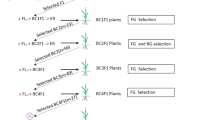Abstract
Spikelet sterility is one of the poorly understood complex problems in rice and rarely harvest index exceeded 50 % in crop plants. Experiments were conducted on 800 rice cultures belonging to wide range, to identify genotypes that have low spikelet sterility, and N influence on selected genotypes, adapting a split plant technique approach to reduce sterility and removal of spikelets from panicles. Genotypes belonging to IR64 background (VG lines) and Tequing (TG lines) and other groups were screened. TG lines and japonica had greater percentage of filled grains and also relatively higher chaff content compared to that of VG lines. Application of nitrogen resulted in significant increase in secondary branch number, confirming that these were controlled by fertilizer application, while filling of spikelets on primary branches seems to be under genetic control. Evidence using retransplanting splitted transplanted seedlings after four tiller stage did not show significant yield reduction and harvest index. Spikelet removal technique from apical, middle and or basal regions for 1/3rd of the panicle, resulted in an increase in percentage filled grains, which was more when apical region spikelets were removed than at the basal region. In hybrids, the increase was as high as 20 %. Regression equations for all possible six combinations were developed for deriving a quadratic equations for (%) filled grain and grain weights separately for varieties and hybrids. Based on these experiments, 5–10 % in varieties and 10–20 % in hybrids spikelets are physiologically sterile. It will be possible to increase 5 % grain yield in rice by management and by breeding for rice yield improvement.


Similar content being viewed by others
References
Ansari, T. H., Miyazaki, A. T. Yoshida, & Wang, Y. (2003). Analysis of ripening process of spikelets in rice cultivars with different grain size. Environment Control in Biology, 41, 321–334.
Bond, J. A., Walker, T. W., Ottis, B. V., & Harrell, D. L. (2008). Rice seeding and nitrogen rate effects on yield and yield components of two rice cultivars. Agronomy Journal, 100, 393–397.
Directorate of Rice Research. (2006). Progress report. Crop Production All India Co-ordinated Rice Improvement Program (Vol. 3, pp. 6.39–6.72). Hyderabad: Directorate of Rice Research.
Directorate of Rice Research (2007). Progress report. Crop Production All India Co-ordinated Rice Improvement Program (Vol. 3, pp. 6.24–6.36). Hyderabad: Directorate of Rice Research.
Gravois, K. A., & Helms, R. S. (1992). Path analysis of rice yield and yield components as affected by seeding rate. Agronomy Journal, 84, 1–4.
Harrell, D. L., & Blanche, S. B. (2010). Tillage, seeding and nitrogen rate effects on rice density, yield and yield components of two rice cultivars. Agronomy Journal, 102, 592–597.
Kato, T. (2004). Effect of spikelet removal on the grain filling of Akenohoshi, a rice cultivar with numerous spikelets in a panicle. Journal of Agricultural Science, 142, 177–181.
Kato, Y., Kamoshita, A., & Yamagishi, J. (2008). Pre flowering abortion reduces spikelet number in upland rice (Oryza sativa L.) under water stress. Crop Science, 48, 2389–2395.
Khan, R. I., & Choudhuri, M. A. (1999). Effect of spikelet removal on the whole plant senescence. Biologia Plantarum, 133, 105–114.
Kobata, J., Akiyano, Y., & Kawaoka, J. (2010). Estimation of unfertilized grains in rice. Plant Production Science, 13, 289–296.
Kobata, T., Nagano, T., & Ida, K. (2006). Critical factors for grain filling in low grain ripening rice cultivars. Agronomy Journal, 98, 536–544.
Mohapatra, P. K., Patel, R., & Sahu, S. K. (1993). Time of flowering affects grain quality and spikelet partitioning within the rice panicle. Functional Plant Biology, 20, 231–241.
Ortega Blu, R. (2007). Analysis of factors affecting spikelet sterility in flooded rice under field conditions in Chile. Archives of Agronomy and Soil Science, 53, 183–192.
Patel, R., & Mohapatra, P. K. (1996). Assimilate portioning within floret components of contrasting rice spikelets producing qualitatively different types of grains. Australian Journal of Plant Physiology, 23, 85–92.
Sheehy, J. E., Dionora, M. J. A., & Mitchell, P. L. (2010). Spikelet numbers, sink size and potential yield in rice. Field Crops Research, 71, 77–85.
Venkateswarlu, B., Prasad, G. S. V., & Prasad, A. S. R. (1981). Studies on nature of relationship between grain size, spikelet number, grain yield an spikelet filling in late duration verities of rice (Oryza sativa L.). Plant and Soil, 60, 123–130.
Voleti, S. R., & Singh, V. P. (1996). Influence of low light irradiance on grain filling in rice (Oryza sativa L) cultivars. Journal of Agronomy and Crop Science, 176, 1–4.
Wang, F., Cheng, F., & Zhang, G. (2007). Impact of cultivar variation in grain density of rice panicle in grain weight and quality. Journal of Science of Food and Agriculture, 88, 897–903.
Zhang, B., & Yamaguchi, J. (2010). Response of spikelet number per panicle in rice cultivars to three transplanting densities. Plant Production Science, 13, 279–288.
Acknowledgments
Our thanks to Dr. B. C. Virakthamath (PD, DRR), Dr. B. Mishra and technical staff of Plant Physiology section.
Author information
Authors and Affiliations
Corresponding author
Rights and permissions
About this article
Cite this article
Voleti, S.R., Nageswara Rao, D., Sailaja, B. et al. Spikelet dominance and sterility in rice (Oryza sativa L.) genotypes: a mechanism of survival?. Ind J Plant Physiol. 18, 1–6 (2013). https://doi.org/10.1007/s40502-013-0005-3
Received:
Accepted:
Published:
Issue Date:
DOI: https://doi.org/10.1007/s40502-013-0005-3



